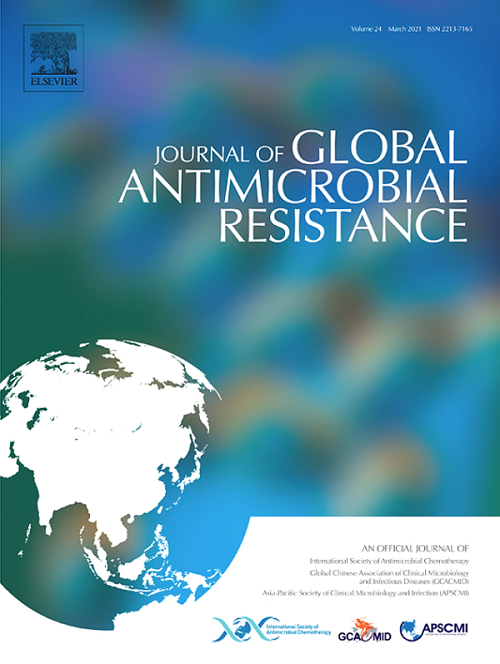Epidemiological insights into global metallo-β-lactamases-producing pseudomonas aeruginosa: A comprehensive analysis based on NCBI database
IF 3.2
3区 医学
Q2 INFECTIOUS DISEASES
引用次数: 0
Abstract
This study aims to analyze the distribution of metallo-β-lactamase (MβLs) encoding genes in global Pseudomonas aeruginosa. Genomes of P. aeruginosa (21,788 in total) were obtained from the NCBI database and annotated using Prodigal to ensure consistency. Blastn analysis was conducted to compare the structured blaMβL databases with annotated genomes to obtain detailed distribution of all blaMβL genes in all genomes. A self-written sequence typing tool was utilized for sequence typing analysis on blaMβL carrying P. aeruginosa, and meta-information of strains was extracted for further analysis. Out of 21,788 genomes, 2,639 (12.1%) contained 4,014 blaMβL, with blaVIM being the most prevalent (51.2%), followed by blaIMP (24.1%) and blaNDM (23.4%). Twenty-four blaVIM variants, with blaVIM-2 being the most common, accounting for 73.2%; There are 39 variants of blaIMP, mainly blaIMP-1 and blaIMP-7, accounting for 16.1% and 14.5%, respectively. Among 2,639 P. aeruginosa carrying blaMβL, 109 distinct sequence types (STs) were identified, with ST235 (16.8%) and ST111 (16.7%) being the predominant types, followed by ST308 (372, 14.1%), ST233 (190, 7.2%), ST357 (144, 5.5%), ST1203 (108, 4.1%), and ST773 (105, 4.0%). Notably, blaMβL-producing P. aeruginosa showed a continuous increase, peaking in 2019 since first detection in 1997. These strains were predominantly isolated from human sources (1,836, 69.6%), primarily from urine samples (21.9%). The predominant metalloenzymes in global P. aeruginosa are blaVIM-2, blaIMP-1, and blaIMP-7, primarily associated with epidemic high-risk clones ST235, ST111, and ST308. Given the rising trend of blaMβL-producing P. aeruginosa, enhanced infection prevention and control measures are warranted.
全球产金属β-内酰胺酶铜绿假单胞菌流行病学研究:基于NCBI数据库的综合分析
本研究旨在分析金属β-内酰胺酶(MβLs)编码基因在全球铜绿假单胞菌中的分布。从NCBI数据库中获得铜绿假单胞菌(P. aeruginosa)的基因组(共21,788个),并使用Prodigal进行注释以确保一致性。Blastn分析将结构化的blaMβL数据库与带注释的基因组进行比较,获得所有blaMβL基因在所有基因组中的详细分布。利用自行编写的序列分型工具对携带blaMβL的铜绿假单胞菌进行序列分型分析,并提取菌株元信息进行进一步分析。在21,788个基因组中,2,639个(12.1%)包含4,014个blaMβL,其中blaVIM最多(51.2%),其次是blaIMP(24.1%)和blaNDM(23.4%)。24种blaVIM改型,blaVIM-2是最常见的,占73.2%;blaIMP有39种变异,主要为blaIMP-1和blaIMP-7,分别占16.1%和14.5%。在2639株携带blaMβL的铜绿假单胞菌中,共鉴定出109种不同的序列类型(STs),其中ST235(16.8%)和ST111(16.7%)为优势序列类型,其次是ST308(372, 14.1%)、ST233(190, 7.2%)、ST357(144, 5.5%)、ST1203(108, 4.1%)和ST773(105, 4.0%)。值得注意的是,产生blam β l的铜绿假单胞菌的数量持续增加,自1997年首次检测到以来,在2019年达到峰值。这些菌株主要来自人类来源(1836株,69.6%),主要来自尿液样本(21.9%)。全球铜绿假单胞菌中主要的金属酶为blaVIM-2、blaIMP-1和blaIMP-7,主要与流行高危克隆ST235、ST111和ST308相关。鉴于产blam β l的铜绿假单胞菌呈上升趋势,有必要加强感染预防和控制措施。
本文章由计算机程序翻译,如有差异,请以英文原文为准。
求助全文
约1分钟内获得全文
求助全文
来源期刊

Journal of global antimicrobial resistance
INFECTIOUS DISEASES-PHARMACOLOGY & PHARMACY
CiteScore
8.70
自引率
2.20%
发文量
285
审稿时长
34 weeks
期刊介绍:
The Journal of Global Antimicrobial Resistance (JGAR) is a quarterly online journal run by an international Editorial Board that focuses on the global spread of antibiotic-resistant microbes.
JGAR is a dedicated journal for all professionals working in research, health care, the environment and animal infection control, aiming to track the resistance threat worldwide and provides a single voice devoted to antimicrobial resistance (AMR).
Featuring peer-reviewed and up to date research articles, reviews, short notes and hot topics JGAR covers the key topics related to antibacterial, antiviral, antifungal and antiparasitic resistance.
 求助内容:
求助内容: 应助结果提醒方式:
应助结果提醒方式:


